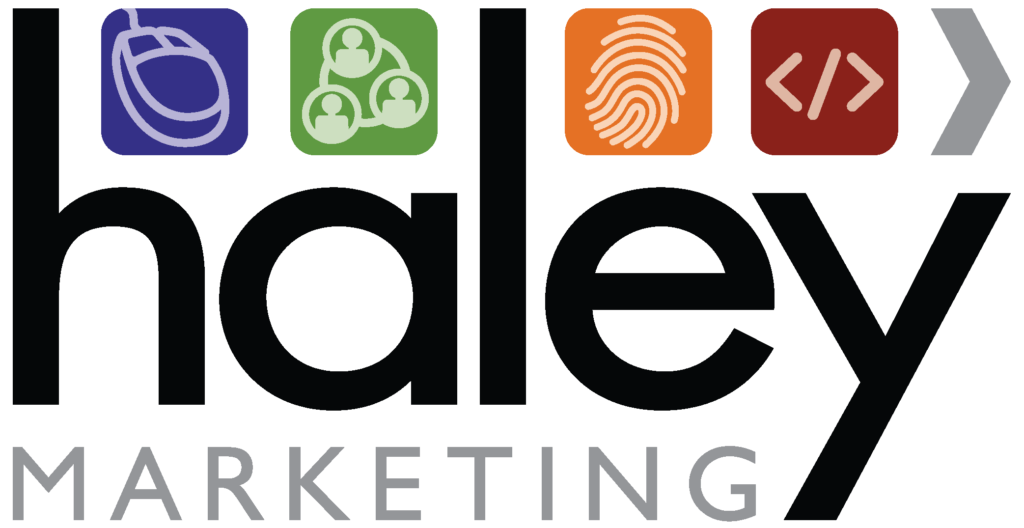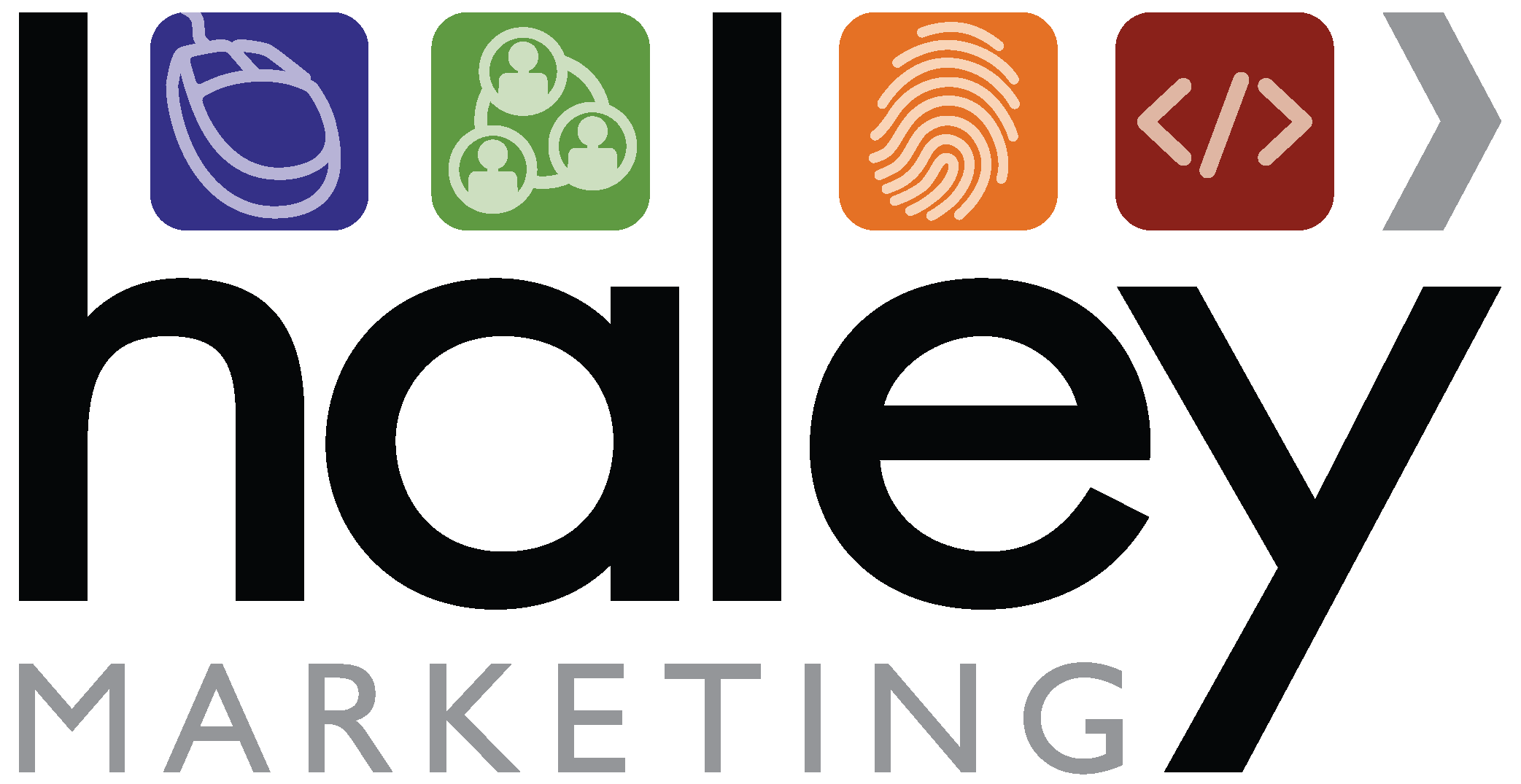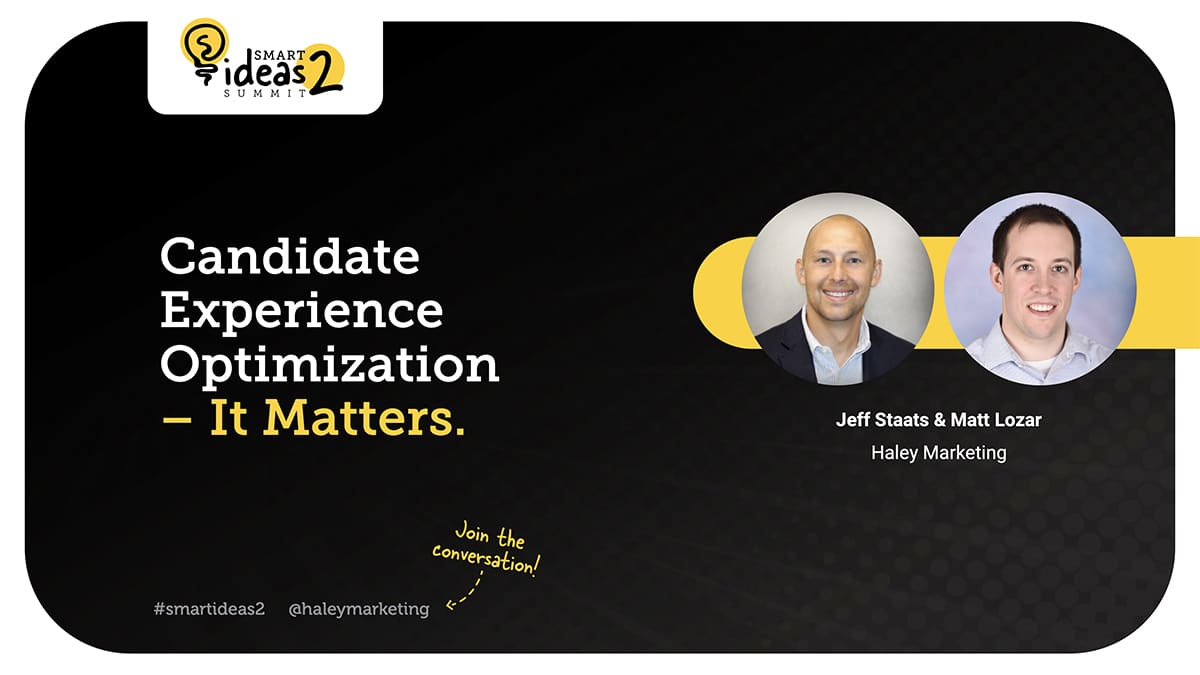The SMART IDEAS Summit 2 was a huge success! Thanks to everyone who attended and made this year’s Summit even bigger and better than last year!
If you missed a session, want to re-watch a favorite, or share any of the presentations with your friends or colleagues, you’re in luck:
The SMART IDEAS Summit 2 Content Is Available on Demand!
Access the free recordings and slides for 14 educational presentations from some of the smartest minds in staffing here. Simply enter your contact information, and then click on any session to start viewing!
Session Recap: Candidate Experience Optimization – It Matters
In this presentation, Jeff Staats (Chief Marketing Officer) and Matt Lozar (Director of Recruitment Marketing) uncover the top obstacles preventing candidates from applying to your jobs. Learn the impact of candidate expectations and gain insight into how your firm can reduce ghosting, increase qualified candidates, and keep top candidates engaged after hiring:
Video Transcript
Jeff Staats:
We’re hearing a lot about misalignment of budget. I’m spending too much money for entry level jobs or low skill jobs. I’m blowing my budget on entry-level jobs, and I don’t have enough money for some of the other stuff. That’s one of the issues that we’re hearing right now. And yeah, I think it continues. I’m sure you’re seeing it with your clients all the time.
Matt Lozar:
We see it a lot, Jeff. It’s just, I call it runaway jobs where let’s say you have 20, 50 jobs posted and a handful of them will get 200, 300 applies, and other ones who won’t get a lot. There’s stats out there. 48% of jobs get 2% of the applies and vice versa, so it’s vital to make sure your budget’s correct to help you fill more positions.
Jeff Staats:
I’m sure you guys are hearing this: “Your application is too long, too confusing,” or there’s too many not required areas where you’re not getting information. Another issue we’re seeing, mostly on my side, is “Your messages are too robotic. I’m not getting the engagement because it reminds them of a dentist’s office reminding them of an appointment.” That is definitely a big one with candidate experience and one of the problems.
Your candidates don’t know where they are in the process.
They apply. Maybe they fat-thumbed through a bunch of different jobs. They apply, and then where are they? What happens? And so all of these issues we’re seeing, and I think we’re seeing it more and more now, especially as these jobs and the unemployment rate comes down and jobs are open, is that candidates have the pick of the litter in terms of pay rates and everything else.
So we’re seeing these problems pop up as we’re talking to clients. The facts is:
Candidates have expectations. They want next steps. They want to know what’s going to happen.
I think this immediate gratification is probably more of a gen Z thing, but I think every one of us has it. I mean, even being a gen Xer, we want immediate gratification. I applied. Why don’t I get the job right now? Where am I? What time should I get to the interview? They want to know this and, especially with technology, they want immediate gratification. What happens? What’s going on? Where should I be? What do I do? This came out of Staffing World last year: 70% of qualified candidates are gone within seven days. I would even argue, quicker than that. I would say five days. If you don’t make them happy, they’re gone.
Matt Lozar:
They go super fast, Jeff. I think it’s, and let me jump in here on the impact of a poor candidate experience. My big takeaway is from the e-commerce side: basically we want to know where we are in the process. I go to <insert your website here>. I purchase something. I get an email or text telling me my order’s been received. Here’s when it’s coming. Here’s when it’s on the truck. Here’s when the truck may have driven by and not delivered it today, but it’s coming tomorrow, and I have instant notifications on everything, and all of that comes over too. We become consumers in the recruiting space, and with so many job openings, a poor candidate experience can be really detrimental to filling jobs.
Jeff Staats:
It’s visibility. It’s transparency into the process. That’s what candidates want. And again, we see it on the automation side. When we work with clients, we help them let their candidates know where they are.
Candidates are lost in the funnel, and I’ve had conversations where there are so many candidates in new lead status and I’m like, “Okay, who’s following up with them?” And the client says, “We don’t even know who’s in there.” And again, it becomes that 100 people apply. You take the top 10 or the first 10. You move on with that and then those other 90 are lost.
Another impact is longer time to fill. You’re not filling jobs quick enough. You’re getting poor candidate quality because again, you’re not being where you need to be to stay in front of them. You’re not grabbing those A-players.
And I think one thing is, you’re not able to scale that recruiting process. I know being on the staffing side, we have recruiter turnover like crazy, just like a lot of staffing firms, and if you don’t have the candidate experience down, you’re not scaling that. You don’t have a process. You don’t have anything documented. Because of that, you don’t know what to teach. You don’t know what’s a part of the process. You don’t know what’s human or what’s automation. If you don’t have that scalable process, you’re going to have problems, churning out problems, churning out problems. And all of it means wasted job ad spend to start and missing revenue to finish.
So how do you make your candidate experience world class?
We all say, “We have world class service.” How do you make your service world class in today’s society—using the right level of technology and strategy, without losing the human touch? There are two critical areas that we’re going to focus on. First, Matt’s going to talk about before the apply. What does that look like? And then we’ll take the process further.
Matt Lozar:
Before the apply: post your jobs where job seekers will find them.
Thanks, Jeff. It definitely starts before the apply because as you can see on the screen here, there’s a Google search and 70+% of job searches start on Google, so it’s vital to have your jobs everywhere. One to start. If someone goes to Google, someone searches for your jobs on Google, is it going to pop up with a link back to your website, so someone can apply there? Is it going to show up in Google for Jobs? Where are your candidates spending time? Where are the active candidates spending time? Where are the passive candidates spending time? How will candidates find your jobs? That’s what’s really vital because your candidates are spending time in different places.
The active candidates are probably on the job boards out there looking for jobs. They’re in your email, looking at the job alerts that are coming through every day. Now I talked about 70% job searches start right on Google, so that’s a big part of it. On social media, are your jobs on the right platforms? The warehouse candidate is probably spending, or the healthcare candidate, might be spending more time on a Facebook while a IT professional, a C-level suite, could be spending time on LinkedIn. It could be vice versa, but are you sharing jobs on the right platforms? Are you using the right tactics on those platforms, because it’s vital to make it easy for someone to convert. We want to reduce friction.
Reduce friction.
And as you see, as we walk through the application, that’s what’s really important because we need to make it really simple. Can you do one-click apply? And yes, there’s pros and cons to both sides of that, because one click apply, two click applies, can lead to unqualified candidates, but we need to make it easy for people to apply because there are so many open jobs, right? 11 million open jobs right now. Job postings are up 50% to 60%, compared to pre-pandemic. That’s a lot of jobs. So what can we do to make it simple.
For example, at Haley Marketing, we switched the apply process on the Haley Marketing Career Portal. A couple of years ago, we switched the standard application to a much shorter form, and that led to a 27% increase in applications.
As you walk through your perfect candidate experience, and you apply for your jobs, where are your jobs being shared? Are they being posted to ensure you’re finding the right candidate at the right time? Are they active candidates? Can they find your jobs easily on the big job boards? Are your jobs fresh on those job boards? Is it quick and easy to apply there? Because old jobs get pushed down. Old jobs don’t show up in the algorithm as much. If they’re 7 days old, 14 days old, a month old, they’re not going to get clicked on as much.
We did research here a couple of years ago that showed around that 14 day mark, the number of clicks just goes down, so that’s really important. On the flip side, when someone then finds your job, how quick and easy is it to apply? If they’re on Indeed or ZipRecruiter, a native apply right on there is going to lead to more applications, which can be good and bad, but it’s going to lead to more applications. It’s going to lead to lower cost applications because someone can just stay right in that app or on that website and not have to bounce around. On Facebook too, conversions will decrease if you send someone to Facebook back to your website. How can you leverage the tools on Facebook to really make it quick and easy with the apply process? And then once we have the applies, we have to follow up with those candidates so they don’t get lost in the funnel.
Jeff Staats:
After the apply: follow up with applicants.
We actually had just a conversation with a client about Facebook lead ads for apply. I’m seeing that more and more: where they’re using either a lead ad or paid strategies on social to get applicants to semi-apply, but not really, like, “Hey, we have these types of jobs. Are you interested? Fill it out.” Now what happens? And what’s interesting about that is, with the job boards, there are processes. When you apply to Indeed, you get an email, you get a notification or something happens. But when you apply through social, especially now that Facebook Jobs is gone in the US, there is no notification process, unless you put something together. So we’re actually working with a number of clients that are trying to figure that out.
It’s important to set the tone, the expectation, up front, but it continues after the apply. You hear all these rants on LinkedIn. “Hey, I applied to this job, and I didn’t hear anything back. What’s going on? A recruiter never followed up. This stinks. They stink.”
I think that there’s so much opportunity in setting that tone, no matter where they come from in the application process, what funnel, what entry point, but you’ve got to set the tone. Usually automation is the most effective, efficient way to do it.
This is just something that we work on with our clients: the top 25 automations. We believe every staffing firm should have at least 25 automations. So if you’re using Bullhorn Automation, Sense, any of that, this is the roadmap that we talk about. For the purposes of this presentation, we’re going to really focus it in on that apply date, interview date, and we’ll talk about a couple of different examples, but it’s really homing in on what do you do when it comes from Source over to Qualify—and you want to hire them.
You’ve got to find a way to go after your A players. So two things that I would do:
Send an immediate post-apply thank you.
Whether it’s a text for a lower skill job or an email for a higher skill job, there needs to be a post-apply thank you. “Thanks a lot. Our team will be reviewing your application, your resume, your background. Somebody will get back to you within X number of hours, 24 hours, 48 hours, 72 hours.” That’s the 101. Here’s the 201 is: give them some pre-qual or next steps. Tell them what to expect next.
Give them a survey for pre-qual. If they’re in light industrial, ask, “Are you 18? Are you authorized to work? Do you have these certs?” If they’re in healthcare, ask, “Do you have these skills?” If you have 100 people applying, you’re able to narrow it down when you make that applicant work a little bit by answering some questions. By using automation, your recruiters are now talking to the 20 engaged applicants versus chasing down 100. And I think that’s the 201 side of this, is being able to put them into some sort of funnel that asks questions and shares next steps.
Once you have that human handoff, re-engagement occurs in every stage.
Talk to somebody that you haven’t talked to in your ATS in five years. There are so many parts of the funnel, where you’re going to lose them, or you’re going to ghost them. One of our clients does a great recruiting efforts with a post-apply thank you and some pre-qual questions. A human recruiter follows up with applicants for maybe one to three business days. If they are not owned as a candidate owner, or however they want to change their status, then they fall into recruiting efforts, and you’re standing in front of them for the next three weeks or so. That has actually gotten them about 8% conversion rate on those potentially ghosted candidates.
You can look at re-engagement in other areas as well. I mean, it’s re-engagement when you go from “interview scheduled” to “completed an interview.” Consider those different funnels and have automations in place to catch those potential ghosts. It should be done, and that again, keeps them aware. It matches applicants’ expectations, and it helps them just drive next steps. Those are the two things I would focus on in terms of the candidate experience.
Map your candidate experience all the way through.
I promise you, you will identify gaps in the process. You will identify gaps in messaging or engagement, the two big uses of automation, and you will be able to have at least three to five aha moments of like, “Oh, yep, totally. I can’t believe that we leave them in that new lead status and nobody talks to them.” There’s so much opportunity there.
Avoid robotic messaging.
The last one is, again, it kind of focuses on avoiding robotic messaging. Use your brand voice. And again, I don’t know if you would do that on the application. I think putting your personality out in the application and who you are as a company and who your client is and how you work, I think that’s important, but I don’t think candidates are stupid. They know that they’re automated messages, but if you are a witty, fun staffing firm or executive recruitment firm, then use that brand voice in those replies or messages wherever candidates are in the process.
Matt Lozar:
I think walking through that candidate experience is big, and I’d like to take a step back. It hits me when I’m outside of the work day. If I’m traveling, or locally, what restaurant I want to go to, looking for a hotel, or I’m in a new city and I want to find a restaurant. That’s how you could walk your candidate experience. Take a step back and say, okay, someone’s looking for a manufacturing job in your city. Take a step back and walk through it. Try to be as simple as possible. Pretend you’re someone going through the search. They don’t know anything about your company, the job, anything. Have someone you can trust to walk through that, and don’t tell your team. Have them walk up your candidate experience and really reduce that friction in the application process.
David Searns:
We’ve got a couple questions that have come in. One question is, on the automations, are you having a candidate thank you email with the ability to go to schedule with a Calendly or some other tool like that?
Jeff Staats:
That’s 301. I would definitely do that. So Sense has something called Meetings. I think that is a great part. One of them, especially on the light industrial, you can have knockout questions. Are you 18? Are you authorized? If you pass through, schedule a time with our recruiters right here. That puts the onus on the candidate to do the work, and then you’re talking to the ones who want to be engaged.
David Searns:
All right, next one. Do you have any suggestions for tools to map out the recruiting process in a clear and efficient way?
Jeff Staats:
So there’s probably some cheap ones, almost like a VIZIO type of thing. Anything with a flow chart. PowerPoint always has the flow chart. I start by drawing. Get a whiteboard, draw the process. What happens when, who does what, when? And then if you want to use tech tools, go for it, but then you can plug in, okay, this is where automation should fit. This is where we should send a message out. Here is where we should do a recruiter check-in.
David Searns:
How frequently should you contact, by email or text, passive candidates?
Jeff Staats:
I think… So, what I always tell our clients is, what does passive mean? Because there’s a couple of different definitions of passive. So again, is it recent passive? Is it older passive? I think doing a drip email series to recent passives might be good if they were hired, but if they haven’t been out to work in 30 days, then you put together a little passive, “Hey, where are you at in your job search?” campaign. Doing monthly check-ins based off of last note is another great idea. Six months after last note, send a message like: “Hey, what’s going on? Just trying to check in with you.”
Want more smart ideas from the smartest minds in staffing?
Access the free recordings and slides for 14 educational presentations from the SMART IDEAS Summit 2.













